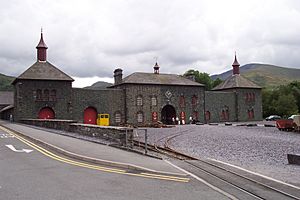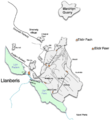Dinorwic quarry facts for kids
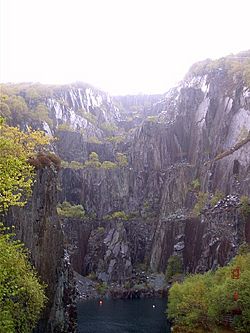
Vivian quarry, part of the Dinorwic quarry
|
|
| Location | |
|---|---|
| Location | Dinorwig, near Llanberis |
| County | Merioneth (now Gwynedd) |
| Country | Wales, UK |
| Coordinates | 53°07′34″N 4°05′53″W / 53.12611°N 4.09806°W |
| Production | |
| Products | Slate |
| Type | Quarry |
| History | |
| Opened | 1787 |
| Closed | July 1969 |
The Dinorwic quarry (also known as Dinorwig quarry) was a very large place where slate was dug out of the ground. It is located between the villages of Llanberis and Dinorwig in North Wales. Today, it is home to the Welsh National Slate Museum.
This quarry was once the second largest slate quarry in Wales, and even in the world! Only the nearby Penrhyn quarry was bigger. Dinorwic quarry covered more than 700 acres (about 283 hectares). It had two main sections, each with 20 levels or "galleries" where slate was mined. There were also many smaller digging areas. Inside the quarry, a huge system of small railways, called tramways, helped move the slate. These tramways used inclines (sloping tracks) to carry slate between the different levels.
Contents
History of Dinorwic Quarry
People first tried to mine slate here for money in 1787. A group of partners rented the land from its owner, Assheton Smith. They had some success, but wars with France, taxes, and the cost of moving the slate made it hard for the quarry to grow.
In 1809, a new business group, led by Assheton Smith, took over. The quarry really started to grow after a special horse-drawn tramway was built in 1824. This tramway connected the quarry to Port Dinorwic, making it easier to transport the slate.
At its busiest, in the late 1800s, Dinorwic quarry employed over 3,000 men! It was the second largest open-pit slate producer in the country. At this time, it produced about 100,000 tonnes of slate each year. By 1930, the number of workers dropped to 2,000, but the quarry kept working until 1969.
Why the Quarry Closed
The quarry closed in July 1969. This happened because the demand for slate was going down, and it became very hard to get the slate out of the ground. After 170 years of digging, many piles of waste rock started to slide into the main digging areas.
In 1966, a huge rockfall happened in an area called Garret. This almost stopped all production. However, they decided to do some final work to clear the waste from this rockfall. This meant building a road for modern quarry vehicles. Only a small amount of slate was found this way, and all work stopped by 1969.
After the quarry closed, its owners had debts. So, a public auction was held on December 12 and 13, 1969, to sell off some of its equipment. The auction included machines, tools, and even four special trains called Hunslet locos. Before the sale, it was announced that Gwynedd County Council had decided to protect the Gilfach Ddu workshops and many items inside them.
Moving Slate: Transport at the Quarry
The first way to move slate from the quarry to the port at Y Felinheli was the Dinorwic Railway. This railway was built in 1824 and had a track width of 2 feet. Horses pulled the wagons on this line. Soon, it became clear that this railway was not big enough for all the slate being produced.
So, a new railway was built. It opened in 1848 and was called the Padarn Railway. This railway had wider tracks, about 4 feet wide. It became the main way to transport slate until the quarry closed in 1961.
Quarry Tramways
The quarry started using small railways, called tramways, around 1800. At first, people and horses moved the wagons on these tracks. For the next 70 years, the tramway system grew. Eventually, they needed more powerful machines to move the slate.
The first steam locomotives (steam trains) used were small ones built by De Winton's in Caernarfon. In 1870, the first locomotive from the Hunslet Engine Company arrived. Most of the trains that worked at Dinorwic were eventually made by Hunslet.
Between 1935 and 1949, the quarry also bought 22 small trains that ran on internal combustion engines (like car engines). Some were new, some were used. These didn't last as long as the steam trains. When the quarry closed in 1969, only three of them were still working.
The tracks at Dinorwic were a bit narrower than what is usually called "two-foot gauge." They were actually about 1 foot 10¾ inches wide. This was similar to the nearby Penrhyn quarry.
Quarry Locomotives
The first steam trains at the quarry were made by De Winton & Co. But from 1870 onwards, most of the new trains came from the Hunslet Engine Company in Leeds. These trains were built specially for the quarry. After 1886, they mostly fell into three main types:
- Alice
- Port: These were bigger and mainly worked at Port Dinorwic.
- Tram or Mills: These trains helped move wagons on the Padarn–Peris Tram Line, which connected the quarry mills to the Padarn Railway.
| Original name / number | Later name | Image | Builder | Year bought | Year sold | Notes |
|---|---|---|---|---|---|---|
| Wellington | De Winton | c1870 | 1898 | |||
| Harriet | De Winton | 1874 | before 1895 | |||
| Peris | De Winton | 1875 | before 1895 | |||
| Victoria | De Winton | 1876 | before 1895 | |||
| Padarn | De Winton | c1898 | ? | |||
| Dinorwic | Charlie |  |
Hunslet | 1870 | by 1919 | |
| George | Minstrel Park | Hunslet | 1877 | by 1919 | ||
| Louisa |  |
Hunslet | 1877 | by 1989 | ||
| Sybil | W. G. Bagnall | 1906 | ? | Being fixed up at the West Lancashire Light Railway | ||
| No.70 | Barclay & Sons | 1931 | 1962 | |||
| Elidir | Avonside Engine | 1933 | 1966 | |||
| Velinheli | 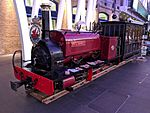 |
Hunslet | 1886 | 1965 | Alice class Now kept at the Launceston Steam Railway |
|
| Alice | King of the Scarlets | 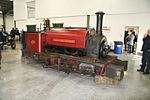 |
Hunslet | 1889 | 1965 | Alice class Kept at the Statfold Barn Railway |
| Enid | Red Damsel later Elidir |  |
Hunslet | 1889 | 1969 | Alice class |
| No.1 | Rough Pup | 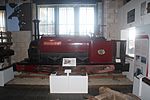 |
Hunslet | 1891 | 1968 | Alice class Kept at the NGM |
| No.2 | Cloister |  |
Hunslet | 1892 | 1962 | Alice class Kept at the Statfold Barn Railway |
| The First | Bernstein | Hunslet | 1892 | 1967 | Alice class | |
| The Second | Covercoat | 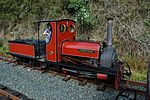 |
Hunslet | 1898 | 1964 | Alice class |
| Wellington | George B. | Hunslet | 1898 | 1965 | Alice class Now at the Bala Lake Railway |
|
| No.3 | Holy War | 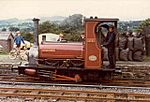 |
Hunslet | 1902 | 1968 | Alice class |
| No.4 | Alice |  |
Hunslet | 1902 | 1972 | Alice class |
| No.5 | Maid Marian (briefly Covertcoat) |
 |
Hunslet | 1903 | 1966 | Alice class |
| No.6 | Irish Mail | 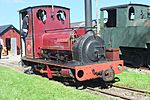 |
Hunslet | 1903 | 1969 | Alice class Kept at West Lancashire Light Railway |
| No.7 | Wild Aster now Thomas Bach | 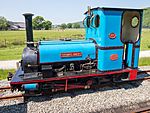 |
Hunslet | 1904 | 1969 | Alice class Now running on the Llanberis Lake Railway |
| No.1 | Lady Joan | 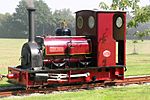 |
Hunslet | 1922 | 1967 | Port class |
| No.2 | Dolbadarn | Hunslet | 1922 | 1969 | Port class | |
| Michael |  |
Hunslet | 1932 | 1965 | Port class Kept at the Statford Barn Railway |
|
| Vaenol | Jerry M | 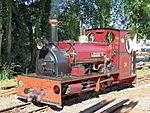 |
Hunslet | 1895 | 1967 | Tram/Mills class Now at the Hollycombe Steam Collection |
| Port Dinorwic | Cackler | Hunslet | 1898 | 1966 | Tram/Mills class |
What Happened After the Quarry Closed?
After the quarry closed, its workshop area, called Gilfach Ddu, was bought by the local council. Today, this building is leased to the National Museum and Galleries of Wales. It is now home to the National Slate Museum, where you can learn all about the history of slate mining.
Some of the old railway equipment from the quarry was used to build the Llanberis Lake Railway. This new railway runs on part of the old Padarn Railway tracks.
The quarry has also been partly used for the Dinorwig power station. This is a special power plant that uses water to create electricity. It's called a pumped storage hydroelectric scheme.
Many of the Hunslet trains that worked at the quarry and the port have been saved. You can now see them on different old-fashioned railways in Britain. Newer versions of these trains have also been built by other companies.
The disused Dinorwic quarry has even been used as a filming location! Parts of the movie Willow were filmed there in 1987. Scenes from Street Fighter and Clash of the Titans (in 2009) were also shot in the quarry.
What is the Quarry Used for Today?
Today, parts of the quarries are popular places for adventure sports. People go rock climbing and scuba diving there. The Blue Peris Mountain Centre, which is run by local councils, uses the quarries for various outdoor activities.
The Vivian quarry section is especially popular for both climbing and diving. Divers can enjoy good visibility in the water, with depths from 6 meters to 18 meters. There's a platform at 6 meters, plus you can see flooded buildings, boats, a van, and even a gnome garden underwater!
Images for kids




